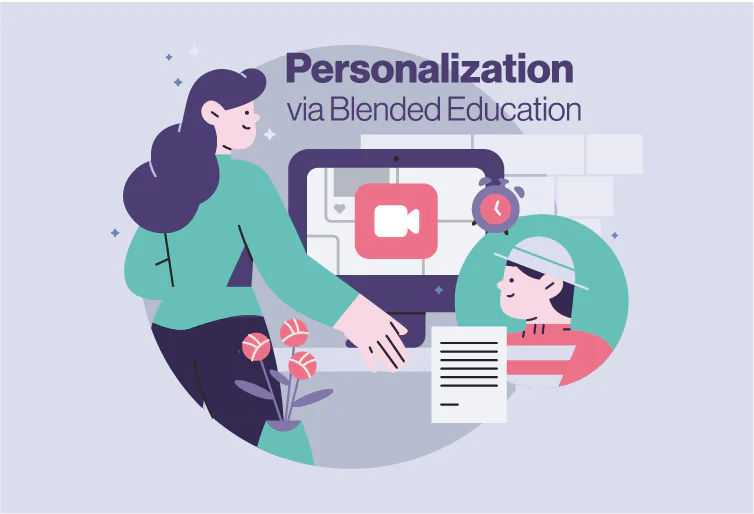Collaborative Work
Blended learning provides a virtual classroom environment that is ideal for collaborative work. Instead of simply presenting content and lecturing, teachers should make use of collaborative approaches to receive a positive response from students. For example, teachers can solve problems together with students so that they develop a deeper understanding of the subject matter by doing instead of watching passively. Collaborative work can help students to hone their problem-solving skills and benefit from new learning perspectives.
A major benefit of online collaboration is that it can help geographically dispersed learners advance in their studies. Online materials and reviews allow for more proactive learning. Trainers and lecturers can provide their input through virtual classrooms to help learners. Hence, a high level of collaboration and engagement is possible through blended learning, even at a distance.
Online Work
The blended learning environment is ideal for online work. You can increase student motivation through the use of videos, images, and animations all of which are facilitated by online learning. Besides presenting content in this way, teachers can also carry out assessments through online tools with automated checking for instance, by using multiple-choice questions. This will help teachers to understand at a moment’s notice how their students are progressing.
Online work can also be customized according to individual needs. For instance, if a student needs a revisit of basic material then you can include it in the online work module for that particular student. Thus online methods can help teachers to devise content and assessments according to individual student needs. A personalized approach that is more targeted towards individual needs can provide better results. Teachers can provide the most relevant information for their students according to their individual needs on one simple-to-use online learning platform.
Structured Learning
Online learning solutions can help students through highly structured learning. As students complete chapters and exercises, the system will update itself to reflect learning progress and show students where they stand. This can help students and motivate them to progress more quickly towards the end of their online course.
Instead of having to repeat the same basic material over and over again, instructors can provide online content so that newcomers can get up to speed quickly. Newcomers can then catch up with the rest of the class even if they were late in joining the online course.
Flipped Classroom
The flipped classroom model makes the best of both the worlds -online and offline learning environments. Students can thus gain benefits from both methods while alleviating their drawbacks.
Thus, the flipped classroom is a better choice for busy professionals who may not always be able to attend the class in person. Instructors can upload slides, notes, videos, and podcasts online so that remote learners will not miss anything even if their busy schedule has prevented them from attending the online class.
Posting material online can also provide other benefits. It can help trainees to quickly comprehend the material so that they can ask meaningful questions during the online session with their instructors. This will help to broaden their knowledge and increase it in a shorter time. Through this approach, instructors can focus on discussions, collaboration, online problem solving, and other equally engaging forms of learning.
Live Online Training
Even before the coronavirus outbreak, online training was taking off in both the academic environment and the corporate sector. Blended solutions for online learning allow students across the globe to collaborate seamlessly with their trainers so that there is minimal adverse impact on their course progress. After the coronavirus outbreak, this superlative feature of online learning has become practically mandatory as it allows students to learn safely while observing social distancing. Blended learning solutions have thus proved to be highly resilient even in the face of the most austere restrictions.
Blended learning solutions are a pragmatic choice for remote learning with a powerful engagement factor. Besides allowing instructors to provide real-time or live training, these methods empower them to accommodate trainees who cannot attend, for instance, due to their shift timing.
Elements of Online Learning
Instructors and teachers can leverage various elements of online learning to facilitate trainees and improve learning progress. They can make use of the following to enhance learning outcomes.
-
Customized content
-
Speed variation
-
Online polling and quizzes with automatic checking
-
Live remote instruction and collaboration
-
Flipped learning methods
-
Use of videos, images, animations, virtual simulations
Thus blended learning solutions permit instructors to leverage the latest technologies in addition to making use of all traditional techniques. The confluence of the new and the old can give rise to improved progress and learning outcomes for trainees.
Thanks to the high level of flexibility and versatility that blended learning solutions purvey, the classroom of the future will be based on this model. This model is enjoying widespread use on all academic fronts including universities, colleges, high schools, and primary schools.
The technology is constantly evolving for a better user experience and faster learning. As further enhancements continue to be implemented in blended learning technologies, both students, instructors and their organizations will reap numerous benefits.
Gradual Approach
If you have just recently begun to implement blended learning solutions, then you can do so gradually to help students adjust more easily to their new environment. Slow and steady is the best approach since not all students can get accustomed that easily to the new learning paradigm. It is important to note that some students could take more time to adjust.
There will also be those who will be savvier with new technology and faster at learning new things than others. Make sure that you provide support for those challenged by the shift in learning.
Some of the best blended learning solutions permit the use of various devices. This will be of great help to everyone since it will enable them to use devices that they are most comfortable with.
Understand the Plus Points
Blended learning methods provide benefits for both students and instructors. These solutions also provide numerous advantages for organizations that implement such systems, including companies and educational institutions.
A prime benefit of blended learning is that it provides a user-friendly ecosystem for real-time collaboration. With blended learning solutions, collaboration will not weaken due to distance. Purists may argue that in-person training is the best way to go. However, that is not always possible since factors like work hours, location, and cost considerations can stand in the way.
Recently, the COVID-19 outbreak has meant that face-to-face interaction is now fraught with several real risks and serious ramifications. Properly implemented blended learning solutions are now the need of the hour to mitigate the threats posed by the coronavirus. In-person learning is simply not possible even with social distancing and other protective measures. Learning cannot happen in an atmosphere of fear. Blended learning solutions allow the possibility of online learning and instruction which can liberate both students and instructors from fear. Distance learning through blended learning solutions is now the only viable way to carry out learning and training.
Real-time interaction through high-quality live video links is the perfect alternative to in-person interaction.
Students and instructors can still work closely while maintaining a safe distance. Besides providing live instruction, instructors can also make use of rich media content to engage students and stimulate learning.
Rotation Model
The rotation model is a highly pragmatic implementation of blended learning solutions. This model works very well since it allows the rotation of students between different activities. In the rotation model, you have the freedom to implement both online and offline methods for the best results. Besides online activities, the rotation model can accommodate all traditional learning activities like independent study, teacher based sessions, peer group interaction, one-on-one sessions with the teacher, and more.
One of the most flexible is the flipped classroom model where students can learn course material in the comfort of their homes through online shared content. They can then attend the classroom (which may be in-person or online) to consolidate what they have learned. The model fosters greater collaboration between teachers and students. This method can provide immense benefits for both students and teachers. Students will benefit because they can learn at their own pace in the comfort of their homes. They do not need to keep up with their teachers for the rest of the class. Weaker students will benefit in particular since they can watch content over and over again without fear of stalling classroom progress.
Teachers can also benefit from this model in numerous ways. They do not have to teach everything from scratch and repeat it. Instead, they now have a more collaborative role where they are in charge of activities designed to deepen learning like reviews, assessments, tests, and discussions. Teachers also do not have to slow down to the level of weaker students. Instead, they can rely on rich multimedia to explain crucial concepts to students in the best possible way such as through animations and visualization. The main job of teachers will then be to explain the more challenging concepts that students do not understand. Students will be able to pick up the basics on their own.
Flex Model
This is another model based on blended learning solutions that both students and teachers can benefit from. The flex model is aptly named since students have the freedom to use either the online mode of learning or on-campus learning where they are face-to-face with teachers. Under the flex classroom model, students can learn at their own pace or opt to go along with in-person instruction. If they happen to struggle with in-person teaching (for instance, it could be too fast for them) they are free to refer to online content for covering any deficiencies in learning. Thus, the flex model is very helpful for shy students who have difficulties asking questions when something is not clear.
Teachers on the other hand can focus more on challenging areas of the course and deepening basic learning of students. If anyone gets left behind, teachers can always move in to help struggling students via online one-on-one tutoring. Teachers also have the freedom to implement learning activities like project-based education and group activities.
A la Carte Model
This approach provides maximum flexibility for students as it allows them to pick content that is most relevant to them. As a result, it is geared towards older students rather than young ones. The advantage of this approach is that students may be able to pick content and courses that are not being offered on campus. Studies can continue online and can also continue beyond school timings.
Conclusion
Blended learning solutions offer numerous advantages that have now become even more vital in these tough times. They afford plenty of flexibility to students, teachers, and institutes alike.
With the best-blended learning solutions, instructors have the freedom to make use of new and old learning methods to get the best of both while minimizing their pitfalls. They provide a high degree of accessibility for everyone so that no one gets left behind.
Strategies for blended learning solutions, as mentioned above, will help you to extract full value from your investment.







